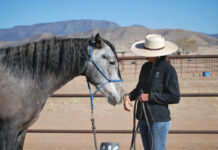Has your riding helmet or equestrian body protector lived out its useful life? How can you know for sure if your safety gear is still functional? Our experts answer some questions about replacing your well-worn equestrian safety equipment.
Dru Malavase, spokesperson and Co-Chair for the ASTM Equestrian Protective Headgear Subcommittee: Old style hunt caps do not contain energy absorbing liners and most of them had inadequate retention systems to keep them on the head when impacted. The short answer is “no.” Any protection they might provide would be minimal and they cannot pass impact testing.
Q: I’m getting back into riding and still have the helmet I wore as a teenager. It’s 10 years old, but still in great condition. Is it OK to ride in?
DM: If it has been stored in a climate-controlled place it might still be in pristine condition, but where damage occurs most of the time is inside the outer shell where crushing of the inner liner cannot be seen without taking the helmet apart. If the helmet has been involved in a fall or impact, there is no way you can be sure that it hasn’t had some crush, even if there is no visible damage.
Some manufacturers recommend that helmets be replaced when they are five or six years old as long as they have not been in an impact; others feel they are still fine beyond that point. Some signs that a helmet needs to be replaced include:
- harness (retention system) pulling loose from shell;
- stitches missing from sewn portions;
- broken teeth on side-squeeze clips;
- white helmets changing color;
- black helmets turning beige;
- surface cracks, holes or dents;
- chunks missing from visible part of lining plastic or plastic shedding small “beads”;
- visible squashing of liner;
- shell or liner cracked.
Q: Do body protectors need to be replaced like helmets do?
Caitlin McConnell, Marketing Manager Phoenix Performance Products/Tipperary Equestrian: Yes, we recommend that you inspect your vest regularly for signs of wear or materials failure. In the event of a fall or impact, inspect the vest thoroughly for signs of possible material failure. Because of the varied applications, usage and exposure of the body protector to outdoor conditions, we suggest it be replaced after five years from the date of purchase.





